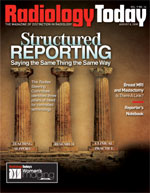
August 11, 2008
Digital Archiving for Mammography
By David Yeager
Radiology Today
Vol. 9 No. 16 P. 6
It’s an accepted axiom that time is money, but in the world of medical facilities, space is money as well. Every patient who walks through the door creates a medical record, and those records need to be stored for years—in some cases for a patient’s lifetime or longer. For instance, Brigham and Women’s Hospital in Boston has archived all patient records since it opened as the Boston-Lying In Hospital in 1832.
Most facilities lack the resources to archive files on that scale, so choices must be made and strategies must be implemented. After all, filling a large amount of prime real estate with medical files limits a facility’s ability to expand services.
“We’ve got a static database of archived [mammography] films that we have to maintain,” says Joe Carpenter, breast center manager for Lourdes Hospital in Binghamton, N.Y. “They take up a lot of space here at the hospital, and there are obviously some opportunity costs associated with that space that we’ve analyzed. Once the films are gone, the space is available.” Carpenter estimates that his facility will free up 1,000 square feet of space by eliminating its hard copy mammography archive.
But those files have to be stored somewhere and, because of Mammography Quality Standards Act regulations, mammograms must be archived for a minimum of 10 years. Increasingly, facilities are turning to off-site storage, either using their own staff or contracting with an archive specialist, to address space issues. This arrangement frees valuable space but creates a new challenge since prior imaging studies routinely need to be shuttled between the off-site archive and the facility.
“We’re currently sending our staff off site to an archived area to bring those images back when the people are scheduled for their procedures,” says Joe A. Gagliardo, executive director of radiology services at Mission Hospital in Mission Viejo, Calif. “We have a very small film room at the facility, and everything is kept off site.”
One way to alleviate this problem is to have the records digitized at the archive facility and accessed electronically from the medical facility. While some companies offer this service for general x-ray, CT, and MRI, mammography has been a particular challenge for this type of data transfer.
New Technology
“The technology to support the spatial grayscale resolution of mammography has just recently been available in the marketplace,” says Stan Burch, vice president and general manager of SOURCECORP Radiology.
SOURCECORP has partnered with VIDAR to provide digital, off-site archiving of film mammography studies. To do that, SOURCECORP uses VIDAR’s CAD PRO, a film digitizer designed exclusively for mammography, which provides the necessary spatial resolution as well as acquisition protocols using the new MG DICOM format. The acquisition protocols ensure that the scanned studies display in the same hanging protocol as full-field digital mammography data. This is important, says Burch, because “the hospital needs to have full-field deployed so they have 5 megapixel display and to really gain the dynamics of eliminating the hybrid viewing environment from film based to soft copy.”
But digitizing mammography files is only half the battle. Burch says one mammography study (four sheets of film) translates to more than 160 megabytes of data, and most facilities require two prior studies per patient. If a typical breast imaging center processes 60 recalls per day, 19.2 gigabytes of data need to be moved for that facility alone.
Lossless Compression
To move the data through a virtual private network (VPN) connection, SOURCECORP uses JPEG 2000 lossless compression. Burch says they’re adding additional T-1 lines to support new clients. The end result is bit-preserving, lossless compression. SOURCECORP’s DICOM VPN tunnel routes the studies to a client’s PACS. Any time a mammography appointment is made, SOURCECORP is alerted and sends the prior studies to the facility’s PACS. If changes need to be made, they can be done quickly.
“If we forget to include somebody on the list or we get an add-on that we hadn’t included and there are some analog films out there to archive, we can get those and add them in there in 15 to 20 minutes,” says Carpenter.
As more facilities move toward remote reading, eliminating hybrid viewing becomes increasingly attractive. Lourdes Hospital processes between 25,000 and 27,000 mammography studies per year. “We’ve got a radiology group who’s reading more and more of their standard cases remotely,” says Carpenter. “To read mammography remotely in the way we’re doing it currently, with the hard copy films being hung on alternators, that makes it very difficult.” He says mailing films also adds considerable time and expense. “So that process of remote reading really isn’t going to work unless you have a complete digital archive that you can make available to the radiologist off site.”
Digital viewing also affects the standard of care. “We feel the radiologist should be looking at previous studies side by side with the existing study on the same mechanism to view,” says Gagliardo. “So I think he has a better result in making the proper diagnosis.”
Gagliardo says there are other benefits to switching to a digital mammography archive. When the archive company collects the films, it also catalogs them. “So in a typical removal of films, you’re finding 3% to 4% of studies that you didn’t even know where they were before,” he says. “They were lost.” In addition, outsourcing brings some quality control benefits. “It enables us to have a little bit more quality control in our system than we’ve had before,” he says.
While some facilities are still considering the best way to manage their hard copy mammography archives, the trend toward full-field digital mammography may lead them to consider digital alternatives. “You have to have a belief,” says Carpenter, “that within the next few years, all of this imaging is going to be done digitally.”
— David Yeager is assistant editor of Radiology Today.

